July 29 Vistula River (Day 306)
The Vistula river bisects Warsaw with the old town on the left bank and a nature reserve along the right bank. We are staying just a few blocks away and finally meandered that way today.

Along the boulevard on the riverbank are sculptures of the fishy inhabitants of the muddy brown river.

The pedestrian bridge over the river.

More sculptures, including of sturgeon, around a fountain.
Fishing seems to be a focus along the river, although we didn’t see any boats or fishermen. I googled it and found this website, The Vistula River Mazowsze, with lots of pictures of the catch from the river, maybe not just right here in Warsaw!
July 28 Biblioteka (Day 305)
Nearby our Airbnb is an interesting green hued building with a rooftop garden. The front is covered with huge panels with writing of different languages, musical scores and mathematical and scientific computations. (A screenshot from the internet)
 This is the Biblioteka Uniwersytecka W Warszawie, the University of Warsaw Library. It was built in 1999 and the garden on the rooftop is open to the public, so we went to visit.
This is the Biblioteka Uniwersytecka W Warszawie, the University of Warsaw Library. It was built in 1999 and the garden on the rooftop is open to the public, so we went to visit.

The stairs up to the rooftop border a skylight framed by greenery that is drained by a watering system that flows into a pool at the bottom of the stairs. At the top of the stairs is a domed arbor shading a domed skylight. A juxtaposition to the domes is the glass light-well illuminating a courtyard surrounded by library stacks.

One of the entrances to the library that is restricted to students and faculty.
July 27 POLIN Museum (Day 304)
We chose one museum to visit today, of the many museums found in Warsaw. The POLIN Museum is a relatively new museum, opened in 2014, it tells the history of Polish Jews over a thousand year period, from the middle ages until the present. The building is in the middle of what was the main Jewish quarter of the city, ultimately the Jewish Ghetto of Warsaw, walled off by the Nazis in 1940.
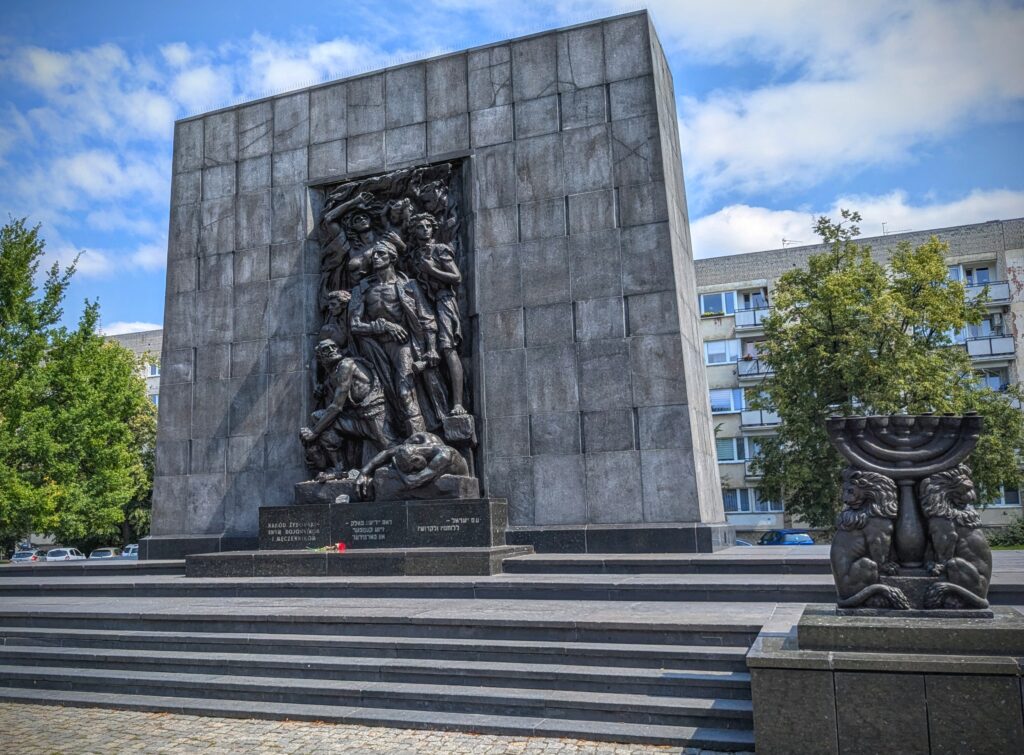
In the plaza in front of the museum is the Monument to the Ghetto Heroes, erected in 1948. It commemorates the Warsaw Ghetto Uprising against the Nazis in 1943 after the “Final Solution” had begun.
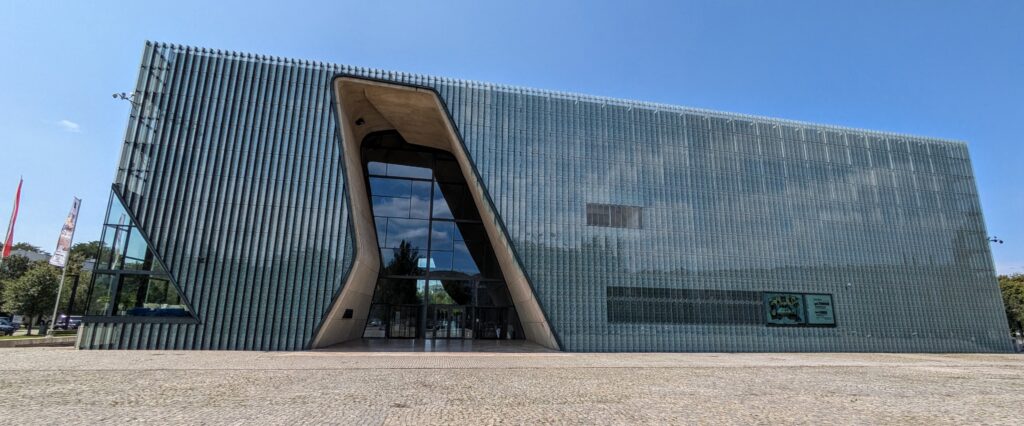
The museum building, opposite the monument, is imposing and somewhat foreboding.
The thousand year history of Jews in Poland is compellingly displayed via artifacts, paintings, models, audio and visual narratives, and immersive settings. We spent several hours following the winding galleries on a chronological journey from the medieval Jewish diaspora eastward through the ‘Golden Age’ of the Polish-Lithuanian Commonwealth of the 15th to the 17th centuries. This era saw relative stability, tolerance and even protection of religious minorities in the Christian state. The Jewish community flourished, but was always regulated and subject to severe restrictions and prejudices.

This recreation of a wooden Jewish Synagogue displays the artistry of the renaissance era.
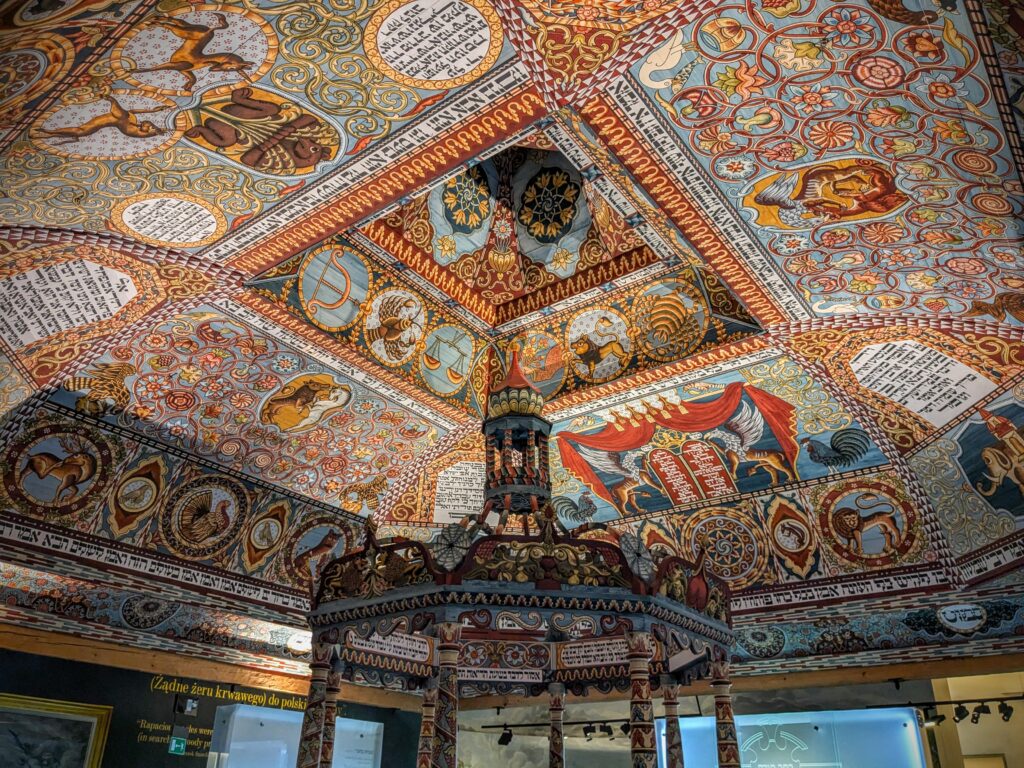
A closeup of the ceiling shows intricate detail. You might notice some astrological references!

This era saw many elaborate wooden Synagogues built. Wood was used not only because it was readily available, but getting permission from the Christian authorities to build a masonry or stone Synagogue was very difficult. Before WWII when the wooden synagogues were deteriorating they were photographed and studied by a scholar who was murdered in the Holocaust. His work was revived after the war by a Polish couple, Maria and Kazimierz Piechotka, and their book “Heaven’s Gates, influenced this recreation of one of those Synagogues. Virtually all of these Synagogues were completely destroyed by the Nazis.
When the Polish-Lithuanian Commonwealth declined, it’s territories were divided between Prussia, Austria and Russia, and Jews were subject to more restrictions based on who’s partition they landed in.

The 3 monarchies under which the Polish Jews were subjected. Left; Frederick II of Prussia. Middle; Emperor Franz of Austria (also known as Francis II, Holy Roman Emperor). Right; Catherine the Great of Russia.
We continued through more galleries detailing everyday life of the Jews, their influence on, and influences by, their Christian neighbors and overall Polish culture. ‘Poland’ regained it’s identity and territory in 1918 after WWI with the defeat of Prussia (a part of Germany by then) and Austria-Hungary, and the revolution in Russia. Eventually we arrived at the galleries detailing the beginning of WWII, which started on September 1, 1939 when Nazi Germany invaded Poland. A new nightmare was then visited upon Jews in Poland and all of Europe.

The persecution especially of Jews by the Nazis and the Christian Poles was systematic and brutal.
The practice of ethnic or any social “cleansing” follows a well documented playbook;
Identify a group to be scapegoated; Jews, Gypsies, Blacks, Gays, Trans, Women, ‘degenerates’, disabled, immigrants, -insert group here-. Make sure you identify them as the perpetrators of whatever economic or health problem that is upsetting, like plague, COVID, recession, depression, unemployment, drug addiction, inequality of wealth, drought, etc.
Humiliate the group; call them cockroaches, stupid, rapists, murderers, drug dealers, always speak in terms of ‘us versus them’.
Label the group(s) to readily identify them; use color of skin, accent or lack of, ethnicity, type of job, shape of nose, clothing they wear, you name it. Make them wear an identifying mark or clothing.
Force them into degrading positions; put them in cages, put a knee on their neck, deny them dignity or autonomy in choices of everyday life.
Separate them from society; physically by forcing them to live certain places, deny them freedom of movement, entry into public spaces, use of facilities, make them use separate facilities because they will ‘contaminate’ your facilities.
and finally Plunder; take everything from them, their labor, children, possessions, life.
Adam Czerniaków, the man holding the papers, was a member of the Polish Senate when Poland surrendered to the Nazi invaders in 1939. The Nazis made him head of the 24 member Jewish Council (Judenrat), responsible for implementing German orders in the new Jewish ghetto. The Warsaw Ghetto was closed to the outside world on November 15, 1940. Czerniaków died by suicide the day after the order to “resettle” the Jews from the ghetto to Treblinka was enacted.
The ‘Final Solution’. It was no coincidence that Auschwitz and Treblinka death camps were set up in Poland, near Warsaw in particular. Warsaw was the epicenter of the Jewish population in Europe, the largest concentration of Jews, and relatively isolated from the prying eyes of the world, insulated by the neighboring territories the Nazis had invaded.

The Nazi architects of the ‘Final Solution’.
To these men the Jews and the other groups that they identified as non-aryan or perpetrators of vague crimes against aryan society, were no longer human beings, not people, just a problem to eliminate, en masse. By the way, their victims had property; bank accounts, houses, furniture, clothes, jewelry, even gold fillings in their teeth, all of which was confiscated, looted, plundered, stolen, to the enrichment of the Nazis.
This is the hardest post I have written. We know the history, but to be in the place where it occurred, to walk the streets where it happened makes it all the more real. To read the words and to know that the playbook is not being rewritten, it is being used almost verbatim, right now, right in the streets we walk now, today, on our televisions, in our living rooms, even by a political candidate for the highest position in the land. Shame, Shame, Shame on us if we let it happen again!
“…while monuments are important for commemoration and memory, knowledge and education are the only true ways to combat our propensity to forget.”
July 26 To Warsaw Poland (Day 303)
Moving on to another city in another country! From Brno, Czechia to Warszawa (Warsaw), Poland, a very early morning train required us to get up before dawn! We stopped at a small Czech town, Česká Třebová, to change trains.
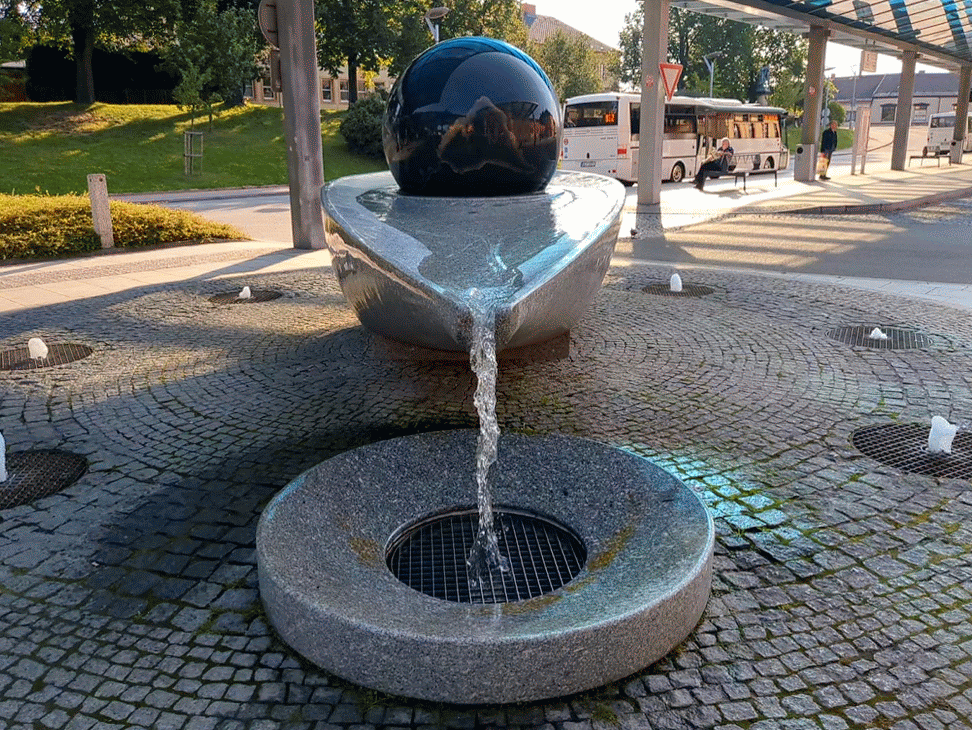
A beautiful fountain in front of the train station.
We then had an almost 7 hour ride on a full train to Warsaw! When we arrived at almost 3pm we had to find the public bus to get to our Airbnb near old town.
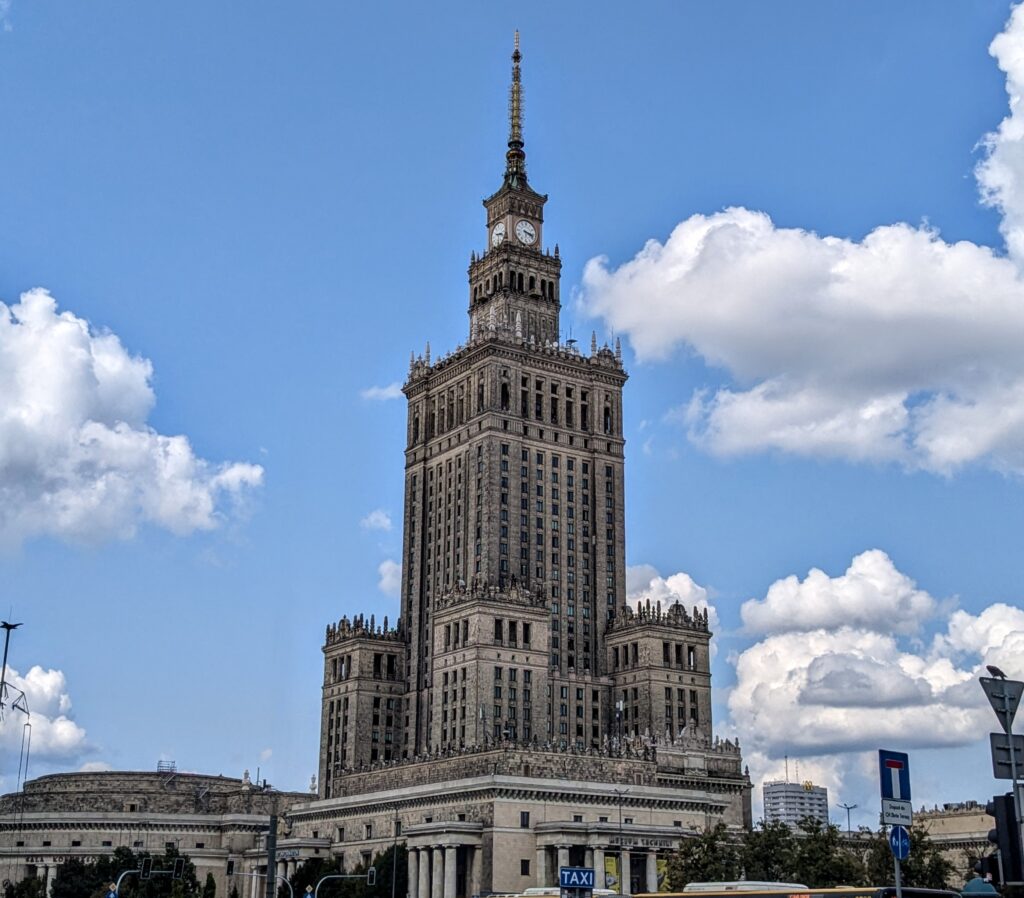
Our first impression of Warsaw! A clean city, a very busy train station and a very efficient public transportation system!
This tall building dominating the skyline near the train station is the Palace of Culture and Science, built in 1950 as a ‘gift’ from Soviet leader Josef Stalin. Because of this it has a divided status in the city, some love it, some hate it as per the “10 Facts You Didn’t Know about …”.
We found our bus and made it to our B&B, unpacked and headed out to check out our surroundings.

Meeting the locals!
We meandered our way towards old town and came to this huge square, filled with families and tourists, with entertainers everywhere! This is Castle Square, bounded on the right side by the red brick Royal Castle, previously the home of Poland’s monarchy, with the focal point in the square being Sigismunds Column, originally erected in 1644 to commemorate King Sigismund III Vasa. Both the original Column and the Castle were completely destroyed by the retreating Nazis in 1945 when they razed the entire city in retaliation for the (failed) Warsaw Uprising of the summer of 1944.
This is Castle Square, bounded on the right side by the red brick Royal Castle, previously the home of Poland’s monarchy, with the focal point in the square being Sigismunds Column, originally erected in 1644 to commemorate King Sigismund III Vasa. Both the original Column and the Castle were completely destroyed by the retreating Nazis in 1945 when they razed the entire city in retaliation for the (failed) Warsaw Uprising of the summer of 1944.
We penetrated deeper into the maze of old town and reached the Old Town Market Square.
 The entire square was reconstructed from 1948 to 1953 due to its complete destruction by the Nazis in 1945. This entire row of town houses comprise the Muzeum Warzawy. The statue in the square is a famous landmark of the city, the Mermaid of Warsaw, found on the Warsaw coat of arms.
The entire square was reconstructed from 1948 to 1953 due to its complete destruction by the Nazis in 1945. This entire row of town houses comprise the Muzeum Warzawy. The statue in the square is a famous landmark of the city, the Mermaid of Warsaw, found on the Warsaw coat of arms.

One way to get around the mostly carless narrow cobblestone streets!

As we headed back to our B&B we saw one more palace!
This is the “Tin Roof Palace” on the edge of old town. Actually the roof is copper with a rich patina! So much history, from its founding in the 13th century this city has been destroyed and rebuilt several times!
July 25 Exploring Brno (Day 302)
A day of religious and cultural exploration! We set out early enough to ensure the cathedral was open for viewing and climbing the bell tower.

The morning light illuminated the stained glass.

At the first level of the bell tower is a room displaying the treasures of the cathedral. This is part of the of the churches treasures, which were looted after several wars, and also sold off in times of destitute after the wars!

The view of the old town from one of the bell towers.
We continued on to the main square of old town where there was a farmers market in progress.

We got gelatos from the pink truck!
Down one street from the square we reached ‘Bishops Courtyard’, where scientific history was made in the 1860’s! The science of genetics began when Gregor Mendel, an Augustinian monk in Brno, conducted experiments with pea plants over several generations from 1856-1863 and deduced that characteristics are inherited from parent plants as distinct units, one from each parent, and that these characteristics can be ‘dominant’ or ‘recessive’, sometimes skipping generations. His work was not recognized for its importance until after his death. In 1900 several other researchers expanded on his 3 “Laws of Inheritance” and further research eventually led to the discovery of DNA as the “units” inherited from the parents. Fast forward to 1975 and I’m in high school learning about Gregor Mendel and genetics and the subsequent research that identified the mechanism of inheritance as DNA. In 1978 I’m in a lab in college painstakingly counting anesthetized fruit flies, separating them by the color of their eyes and the curliness of their wings, breeding them and back-breeding them and again counting them, in order to determine their genetic make-up for my class final exam! The fruit fly is the first animal to have its genetic code fully mapped. Here I am standing in the courtyard where it all began! Unfortunately it was closed and under construction! But it was exciting non-the-less!

At least there was and information panel!
We moved on to other highlights in Brno!

The town hall, expanded and renovated over the centuries from medieval times!

The view from the Town Hall tower, with Spilberk Castle in the left distance.

Inside the Town Hall, the exterior stained glass is as beautiful as the more muted colors of the interior meeting room frescoes!
After a long day walking around town, up and down tower staircases, we headed back to our B&B.

Our view of the Cathedral all lit up for the night!




 This is the
This is the 













 This is
This is  The entire square was reconstructed from 1948 to 1953 due to its complete destruction by the Nazis in 1945. This entire row of town houses comprise the
The entire square was reconstructed from 1948 to 1953 due to its complete destruction by the Nazis in 1945. This entire row of town houses comprise the 









